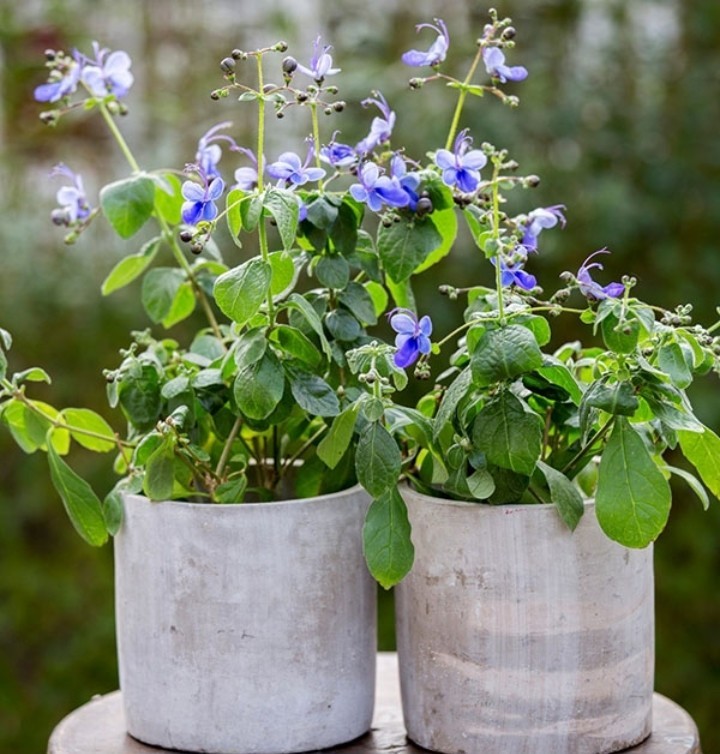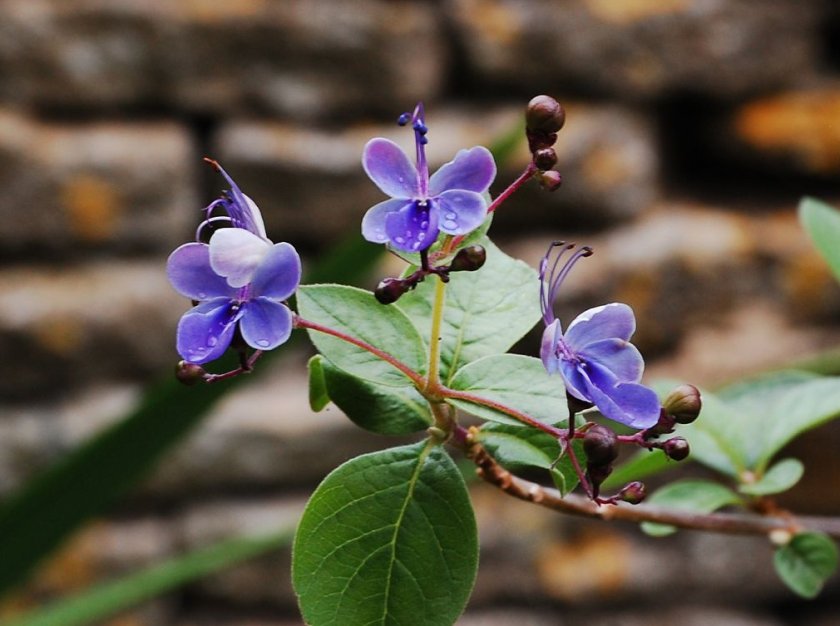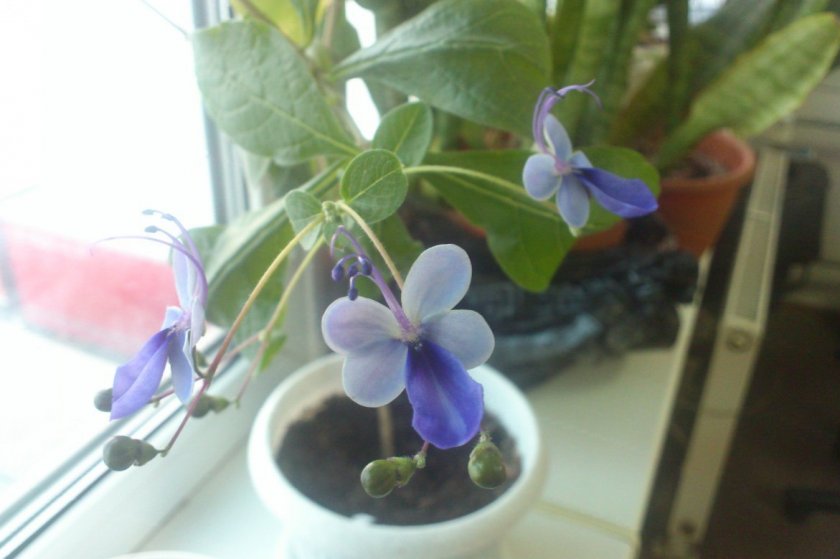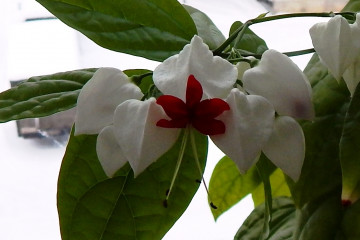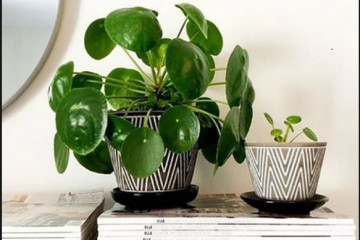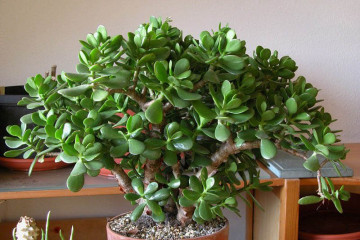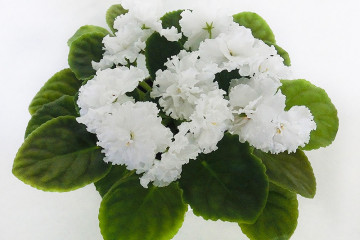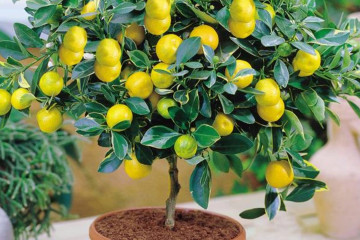The tree of fate - clerodendrum, a beautiful legend about the name of the flower
Content:
Clerodendrum Ugandan is a tropical dwarf shrub native to East Africa and Asia. Clerodendrum in nature grows in three forms: as a small tree or bush, ampelous plant and liana. The tree is popularly given the name Clerodendrum blue, or blue butterflies in honor of the bright light blue flowers. It also has a different name - the tree of fate, because of the legend of attracting joy, luck and luck to oneself.
Clerodendrum Ugandan
Clerodendrum Ugandan is gaining immense popularity among connoisseurs of exotic plants and ordinary flower growers living in the middle latitudes. But the evergreen plant itself grows in Africa and Asia, and is used for decorative purposes.
Botanical description of the plant
Clerodendrum Ugandan is an evergreen perennial plant that belongs to the Verbenaceae family. It has lignified thin shoots, therefore it is classified as half-lianas and semi-shrubs. Shoots can stretch up to 2.5 m in length. The dark green leaf reaches a size of 10 cm, the shape of the leaf is lanceolate with a serrated edge, and there are also smooth edges.
The flower is bright blue in color with large petals, which is very similar to a blue butterfly. One bud contains five petals, each of which is different in color and shape from the others. The one in the middle is much darker than the others and is curved in the shape of a boat. At the very end of the bud are yellow stamens.
A beautiful legend about the tree of fate
The literal translation of the name of the flower means “the tree of fate”. There is a legend that came from the island of Java from Indonesia. It says that the tree has tremendous power. It can bring joy and happiness to your home.
The African peoples have a similar legend. They are known to have worshiped the tree. It was under it that significant rituals of African residents took place. They believed that the clerodendrum tree of fate is capable of attracting only good and happy emotions, as well as good luck and luck.
Why is Clerodendrum Ugandan valuable?
Clerodendrum Ugandan is prized primarily for its beautiful and long flowering. Particularly interesting is the shape of the flowers in the form of blue butterflies, which makes the bush more desirable for gardeners to acquire than the white species - clerodendrum calamitosum. The pleasant aroma emanating from the flowers also attracts attention.
Some gardeners get this look because of the unusual legend associated with the plant. Some believe that it really has the ability to bring good luck and joy.
Clerodendrum Ugandan: home care
Creation of favorable conditions for Ugandan Clerodendrum and care at home does not take much time. The plant is unpretentious in cultivation, so you do not need to have special skills. Basically, you need to monitor lighting, air humidity, careful watering and temperature conditions. After the flowers bloom, pruning and pinching are mandatory so that the plant blooms well for the next year.If you properly care for the plant constantly, then you will not need treatment for diseases and pests.
Temperature regime
For healthy growth of clerodendrum in northern latitudes, it is necessary to maintain a certain temperature. In the summer season, the tree functions actively, but in the winter it needs peace. For this, the room temperature is lowered to 19 ° C. This method helps the plant gain strength and bloom profusely from the beginning of spring. From March to November, the temperature regime for growing the bush is maintained in the range from 19 ° C to 25 ° C.
Air humidity
The basis for the care of Clerodendrum, nicknamed the tree of fate, is to maintain an increased level of humidity. In room conditions, it is not always possible to maintain a certain level of humidity. Regular spraying with soft and slightly cool water will help to increase it in a dry heated room. For additional moisture, the pot is placed on a pallet with water, a container with water is placed near it, or a damp cloth is placed on the heating pipe under the windowsill.
Leaving during flowering
Caring for the clerodendrum tree of fate during flowering includes periodic feeding, maintaining a favorable temperature and moderate watering.
During flowering, the plant is fed with complex organic and mineral preparations. Especially at this time, it is recommended to increase the potassium content in the soil, which affects the lush and abundant flowering. But nitrogen-containing fertilizers should be reduced, and it is better to stop altogether for a while. To prevent the appearance of chlorosis, the plant is treated and sprayed with preparations containing iron.
Flowering time
Clerodendrum blue butterflies bloom for a long period, but not all year round, like another species of Clerodendrum Uruguay. Blooming of buds begins in April after pruning old branches. Flowering continues until November. Then the vine must be sent to rest to accumulate strength.
Diseases, pests, growing problems
The main reason for the appearance of diseases in Ugandan Clerodendrum is improper care. Problems and diseases arising from the tree:
- chlorosis. It is treated with top dressing with a solution of ferrous sulfate or special preparations containing an increased level of iron;
- decay of the root system, due to excessive watering. Regular drainage of the soil and proper watering are necessary;
- yellowing of leaves, drying of the tops of the shoots, shedding of buds. It begins to turn yellow due to a lack of moisture in the soil and air;
- the appearance of brown spots on the leaf plates due to hypothermia. It is recommended to move the pot to a warmer place;
- a spot of yellow and brown color on the leaves. The reason for their appearance is sunburn. You need to move the flower pot to a darker place. Then spray the ground part of the bush with water. For more effective results, you can place the fan close to the pot.
Pests that harm the clerodendrum:
- Lithuanian;
- aphid;
- spider mite;
- whitefly;
- shield.
With a slight pest infestation, it is enough to rinse the bush with soapy water. With extensive damage, special preparations are used, fungicides and insecticides, with which the soil and the ground part of the bush are treated.
Reproduction methods
Clerodendrum reproduces in two ways:
- seeds;
- cuttings.
Reproduction using seeds is carried out at the end of February or at the beginning of March. Seeds are recommended to be planted in a pre-prepared substrate of peat soil and sand.Then it is necessary to water the soil abundantly and cover the pot with foil. After 1.5 months, the first shoots appear.
Propagation by cuttings
Reproduction through cuttings is carried out from April to September. To do this, the elongated shoots are cut in half. The cuttings are divided into cuttings, each must have at least three rows of buds. Then they are placed in a container with water, and on top they are tightly covered with a plastic bag. As soon as the first roots appear, the cuttings are planted in the ground.
Clerodendrum Ugandan is a beautiful and bright flower with unusual inflorescences in the form of blue butterflies. Every year, new types and varieties of clerodendrum are developed, which win the love of gardeners.
